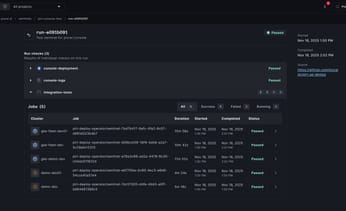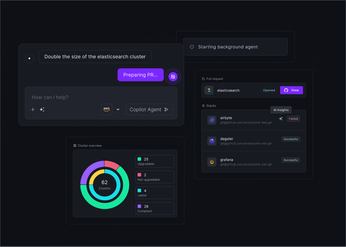
Guide to Multi-Cluster Application Rollout Strategies
Learn how to design a multi-cluster application rollout strategy for Kubernetes, with practical steps, best practices, and tools for reliable deployments.
The main motivation for adopting a multi-cluster architecture is resilience. Distributing workloads across clusters removes single points of failure and ensures availability even during regional outages. However, deployment itself can become a risk factor—an update applied incorrectly can take down the same resilient system it was meant to protect.
A well-designed multi-cluster rollout strategy mitigates that risk, enabling updates without user disruption. It’s a deliberate tradeoff between speed and safety. This article examines key rollout approaches and provides practical guidance for implementing them in Plural, ensuring service continuity while shipping new features confidently.
Unified Cloud Orchestration for Kubernetes
Manage Kubernetes at scale through a single, enterprise-ready platform.
Key takeaways:
- Choose a rollout strategy that fits your risk profile: Match your deployment method to your application's needs. Use rolling updates for simple, cost-effective changes, blue/green deployments for zero-downtime releases with fast rollbacks, or canary releases to safely test new versions with a small subset of users.
- Unify fleet management with a central control plane: Multi-cluster operations create complexity that manual processes can't handle. A unified platform like Plural is essential for enforcing consistent configurations via GitOps, gaining fleet-wide observability, and applying security policies from a single interface.
- Build a foundation of automation and governance: A successful rollout strategy relies on more than just the deployment step. Integrate security scanning, centralized monitoring, and automated rollback procedures into your CI/CD pipeline to create a reliable, auditable, and secure operational framework for your entire fleet.
What Is a Multi-Cluster Rollout Strategy?
A multi-cluster rollout strategy is a structured approach to deploying and updating applications across multiple Kubernetes clusters. Instead of running workloads in a single cluster, you distribute them across different environments—spanning regions, cloud providers, or even on-premise data centers. This approach is key to building resilient, scalable, and high-performance systems that give teams more control over application lifecycles while minimizing deployment risk.
Core Components
A robust multi-cluster strategy treats multiple independent Kubernetes clusters as a coordinated fleet. Each environment—development, staging, and production—operates in its own cluster, ensuring isolation and preventing failures from cascading across environments.
Centralized management is critical. A unified control plane provides a single source of truth for deploying configurations, enforcing policies, and monitoring health across all clusters. In most modern setups, this is achieved through a GitOps-based workflow, where every cluster’s desired state is defined and version-controlled in a Git repository. This enables consistent, automated synchronization across the entire fleet.
Why Use a Multi-Cluster Strategy?
The primary advantage is high availability. Distributing workloads across clusters eliminates single points of failure—if one cluster or region fails, traffic can seamlessly shift to healthy ones, maintaining uptime.
Performance also improves, as you can deploy services closer to users geographically, reducing latency. Multi-cluster setups enhance workload isolation, preventing resource contention and “noisy neighbor” issues. They also provide flexibility to adopt a multi-cloud model, reducing vendor lock-in and improving compliance through data locality.
Common Misconceptions
A common myth is that multi-cluster Kubernetes is only for large enterprises. In reality, advancements in tooling make it viable for smaller teams aiming for better reliability and control.
Another misconception is that multi-cluster setups exist solely for disaster recovery. While resilience is a core benefit, the approach also improves scalability, latency, and regulatory compliance.
Finally, some assume multi-cluster management is inherently complex. While manual orchestration is difficult, platforms like Plural abstract that complexity through a unified control plane, offering streamlined deployment, observability, and governance across your entire fleet.
How Multi-Cluster Architectures Work
A multi-cluster architecture distributes workloads across multiple independent Kubernetes clusters, extending beyond a single control plane to deliver greater resilience, scalability, and global reach. Instead of relying on one cluster to handle all workloads, this model isolates failure domains and supports advanced deployment and recovery strategies. The guiding principle is to treat clusters as interchangeable infrastructure units—ephemeral, easily recreated, and centrally managed. Achieving this at scale requires a robust management layer capable of maintaining configuration, deployment, and observability consistency across the entire fleet.
Plural provides this capability through a single-pane-of-glass console that unifies management for all clusters without exposing internal endpoints. Its secure, agent-based pull model enables consistent control even for clusters running in private networks or on-prem environments. This centralized approach is key to executing coordinated rollouts, enforcing security policies, and maintaining full visibility into fleet health. By abstracting away the complexity of multi-cluster orchestration, platform teams can offer developers a self-service interface for provisioning and deploying applications while preserving governance and operational integrity.
Single vs. Multi-Cluster: Key Differences
The core difference lies in control plane architecture. In a single-cluster setup, one API server manages the entire environment—creating a single point of failure. If the control plane becomes unavailable, the entire cluster’s workloads are at risk.
In contrast, each cluster in a multi-cluster system operates independently with its own control plane. A failure in one cluster—whether due to network disruption, hardware issues, or configuration errors—does not affect others. However, managing multiple clusters introduces operational complexity. Teams must standardize workflows for deployments, configuration management, and monitoring to maintain consistency across potentially hundreds of clusters.
Regional vs. Global Distribution
Multi-cluster architectures allow organizations to deploy workloads closer to users, improving latency and regional performance. For example, applications can run in both North American and European clusters, routing users to the nearest deployment. This setup also satisfies data sovereignty requirements by ensuring user data remains within specified jurisdictions.
Beyond geographic optimization, clusters can also be segmented by purpose—such as team ownership, compliance needs, or environment type (development, staging, production). Coordinating this distribution requires advanced networking solutions like Multi-Cluster Ingress, which intelligently routes traffic to the appropriate cluster while maintaining service availability.
Designing for High Availability
High availability is the cornerstone of multi-cluster design. If one cluster fails, services can continue to operate in other healthy clusters—a principle known as resiliency. This architecture also simplifies maintenance and upgrades. A standard practice is to drain traffic from a cluster before performing updates, temporarily rerouting it to others in the fleet.
To support this model, teams must perform careful capacity planning to ensure remaining clusters can absorb additional load during transitions. Platforms like Plural streamline this process with GitOps-based automation, ensuring consistent deployments and controlled traffic shifts. The result is a resilient, self-healing infrastructure capable of delivering updates without user disruption.
Key Multi-Cluster Rollout Strategies
Selecting the right rollout strategy is essential to maintain uptime and minimize deployment risk in multi-cluster Kubernetes environments. Each approach offers a different balance between speed, safety, and cost. The objective is consistent: update applications or infrastructure without disrupting users. An effective strategy limits the impact of failed updates and enables rapid recovery.
Successful multi-cluster rollouts depend on automation and comprehensive visibility across clusters. This is where a unified management plane becomes crucial. Platforms like Plural deliver GitOps-based deployment and observability tooling that standardize and automate rollouts at scale. With consistent workflows, you can safely apply updates across your entire fleet—whether through a simple rolling update or a more advanced canary or blue/green deployment.
Rolling Updates
A rolling update updates clusters sequentially—taking one cluster out of rotation, upgrading it, and then restoring it to service before moving on to the next. This approach minimizes infrastructure overhead, as no duplicate environments are required.
Rolling updates are cost-efficient and easy to implement but temporarily reduce capacity while clusters are upgraded. They also pose higher risk if a bug is introduced, since updated clusters immediately serve production traffic. This makes rolling updates ideal for less critical applications or scenarios where brief performance dips are acceptable.
Blue/Green Deployments
Blue/green deployments emphasize availability and rollback safety. In this model, the existing production environment (“blue”) continues serving traffic while a duplicate environment (“green”) is deployed with the new version. Once validated, traffic is switched from blue to green. If problems arise, reverting to the blue environment is instantaneous.
This approach nearly eliminates downtime and simplifies recovery. However, it doubles infrastructure requirements during the rollout and introduces complexity for stateful workloads, which may require coordinated data migration or synchronization between blue and green clusters.
Canary Releases
Canary releases reduce risk by introducing new versions gradually. The update is first deployed to a single canary cluster, where it serves a subset of real users. Performance and reliability are closely monitored. If stable, the update rolls out progressively to additional clusters until full deployment is achieved.
This strategy confines issues to a small portion of the environment, allowing teams to detect problems early. It enables real-world testing of new features and performance under production conditions. The main challenges include managing fine-grained traffic routing and requiring strong observability. Service meshes often handle the sophisticated routing logic needed for canary traffic distribution.
Progressive Delivery
Progressive delivery extends canary principles to the feature level. Instead of gating entire versions, new functionality is released gradually using feature flags. Code is deployed to production but activated only for selected user segments—such as internal users or specific regions.
This decouples deployment from release, providing granular control over who experiences new features. Teams can collect feedback and metrics to inform release decisions. However, progressive delivery introduces complexity in managing feature flags and maintaining multiple active feature states. It demands a mature CI/CD pipeline and an experimentation-friendly culture.
Automating Rollbacks
Automated rollbacks are a critical safeguard for all rollout strategies. When performance metrics degrade or deployment failures occur, an automated rollback mechanism should restore clusters to their last known stable state with minimal downtime.
GitOps-based automation makes rollbacks simple and reliable. Since the desired infrastructure state is stored in Git, reverting to a stable version is as easy as rolling back a commit. Plural’s continuous deployment operator continuously monitors both repositories and clusters, applying updates and automatically triggering rollbacks when issues are detected. This ensures recovery is as fast and consistent as the rollout process itself.
Essential Tools and Infrastructure
Manage Your Fleet with Plural
Managing multiple Kubernetes clusters at scale requires centralized control to maintain visibility, enforce consistency, and reduce operational friction. Without it, teams face fragmented management—switching between contexts, dashboards, and credentials—leading to higher risk and slower response times.
Plural addresses this with a unified control plane for fleet management. Its single-pane-of-glass console allows teams to define metrics, alerts, and rollout policies across all clusters from one interface. The agent-based architecture provides secure, pull-based management for clusters across any cloud or on-prem environment—without exposing internal endpoints. This unified visibility is essential for executing coordinated multi-cluster rollouts and ensuring that deployments remain reliable and consistent across your infrastructure.
GitOps for Configuration Management
Configuration drift is one of the biggest challenges in a multi-cluster setup. GitOps eliminates this by establishing Git as the single source of truth for infrastructure and application configurations. Tools such as ArgoCD and FluxCD automate synchronization between your repositories and clusters, continuously applying declarative manifests to ensure consistency.
This model makes deployments auditable, repeatable, and easy to roll back. Plural CD builds on GitOps principles, automatically detecting and correcting drift while supporting Helm, Kustomize, and raw YAML manifests. By codifying configurations, teams can standardize deployment workflows across environments and scale operations without losing control or reliability.
Load Balancing and Service Meshes
Efficient traffic distribution is fundamental to multi-cluster resilience and performance. A global load balancer directs user requests to the nearest or healthiest cluster, ensuring continuity during maintenance or regional failures.
For intra-service traffic management, a service mesh like Istio or Linkerd provides granular control. Service meshes enable fine-grained traffic shifting for rollout patterns such as canary releases and progressive delivery. They also handle key reliability and security features—including retries, circuit breaking, mutual TLS, and observability—making them indispensable for running distributed systems at scale.
Monitoring and Observability
Centralized observability is critical for diagnosing and preventing issues during multi-cluster rollouts. Without a unified view, debugging requires correlating logs, metrics, and traces across clusters—slowing down incident response.
Plural’s built-in observability dashboard aggregates telemetry data from all clusters, offering real-time visibility into resource health, deployment status, and performance trends. This enables teams to track rollouts, pinpoint bottlenecks, and identify anomalies before they escalate. With comprehensive observability in place, rollouts can proceed confidently, ensuring stable and predictable operations across your entire Kubernetes fleet.
Best Practices for a Successful Rollout
A reliable multi-cluster rollout requires more than selecting the right deployment pattern—it depends on disciplined operational practices that promote consistency, security, and resilience across your entire fleet. Even the most advanced rollout strategy can fail without proper controls to prevent configuration drift, enforce security policies, or validate changes before deployment.
These practices are ongoing processes, not one-time configurations. Embedding them into your daily workflows builds an environment where applications can be deployed confidently and safely. The result is fewer manual interventions, reduced risk of human error, and a stronger focus on innovation rather than infrastructure firefighting. The following best practices outline how to operationalize a dependable multi-cluster rollout framework.
Plan Your Deployment
Begin with a detailed rollout plan that defines your objectives, metrics, and rollback criteria. Identify key performance indicators (KPIs) across both infrastructure and application layers—such as latency, error rates, resource utilization, and user experience metrics. Use these KPIs to establish baselines and measure the impact of your deployment.
Clearly define rollout stages by cluster, region, or user segment to ensure controlled exposure and predictable scaling. Just as importantly, document rollback procedures upfront to enable fast recovery if performance or reliability declines. A well-documented plan minimizes reactive decisions and aligns your team on shared goals before execution begins.
Test and Validate
Testing is fundamental to multi-cluster success. Validate not just your code, but also your manifests, Helm charts, and infrastructure definitions. Create a staging environment that mirrors production as closely as possible to uncover environment-specific issues.
Automate integration and end-to-end tests within your CI/CD pipeline to verify functionality across clusters and configurations. Simulate real-world failure scenarios—like cluster outages or network partitions—to confirm that your high-availability design performs as intended. Comprehensive testing ensures your rollout strategy operates predictably under all conditions.
Manage Resources Effectively
Resource consistency directly affects performance in distributed systems. Use Kubernetes requests and limits to define predictable workloads and prevent resource contention. Network reliability is equally critical in multi-cluster setups—implement network policies to secure service-to-service and inter-cluster communication.
With Plural, you can apply GitOps principles to standardize resource definitions and networking policies across all clusters. This eliminates drift and enforces consistent performance and security baselines fleet-wide.
Ensure Security and Compliance
Security must be embedded into your multi-cluster rollout process, not layered on afterward. Centralize identity management with single sign-on (SSO) and apply fine-grained Role-Based Access Control (RBAC) across users and workloads. Plural’s dashboard integrates with your identity provider, supporting Kubernetes impersonation to enforce access rules tied to user groups and emails.
Manage secrets securely using external systems like HashiCorp Vault instead of Git repositories. Because admins have write access to critical configuration repositories—including operators and shared resources—maintaining an auditable GitOps workflow is essential for compliance and traceability.
Integrate with CI/CD
Automation is the backbone of multi-cluster rollouts. Your CI/CD pipeline should handle the full lifecycle—from image builds and manifest updates to post-deployment validation. Integrate your chosen rollout strategy (rolling, blue/green, or canary) directly into this pipeline to enforce consistent delivery patterns.
Plural CD provides an API-driven continuous deployment framework to orchestrate updates across clusters from a centralized control plane. Combined with Plural Stacks for infrastructure-as-code, you can fully automate provisioning, configuration, and deployment through Git-based workflows—ensuring every change is reviewed, versioned, and traceable.
This level of automation transforms multi-cluster operations from a complex, manual process into a repeatable, reliable system that scales effortlessly with your infrastructure.
How to Measure Success and Performance
A successful multi-cluster rollout isn’t just about deploying applications—it’s about ensuring they operate reliably, efficiently, and at scale. Measuring success requires a clear framework for tracking performance, optimizing resources, and responding to issues. This means defining what success looks like, implementing systems to monitor it, and establishing consistent procedures for handling incidents. With this framework in place, raw metrics become actionable insights that drive continuous improvement across your entire Kubernetes fleet.
Define Key Performance Indicators
Before you can measure success, you must define it. Identify key performance indicators (KPIs) for both your infrastructure and applications that align directly with business goals. For infrastructure, track cluster health, resource utilization (CPU, memory), and uptime. For applications, focus on operational metrics such as deployment frequency, change failure rate, mean time to recovery (MTTR), latency, and error rates.
A balanced set of KPIs provides a holistic view of your rollout’s effectiveness—helping you measure not only whether the system is functioning, but how well it’s meeting user and business expectations.
Implement Monitoring Strategies
With KPIs established, the next step is to monitor them effectively. In a multi-cluster environment, visibility is everything. Managing separate monitoring tools for each cluster fragments insights and increases operational overhead. Centralized observability solves this problem.
Plural’s built-in multi-cluster dashboard provides a unified view of all Kubernetes resources across your fleet, continuously updating cluster states and resource conditions in real time. This single-pane-of-glass visibility enables proactive analysis—tracking trends, benchmarking performance, and detecting anomalies before they become outages. It turns observability from a reactive process into an operational advantage.
Optimize Your Resources
Performance and efficiency depend on how well you manage your cluster resources. In multi-cluster deployments, even small misconfigurations can cascade into performance bottlenecks or wasted capacity. Regularly review your resource requests and limits to ensure they reflect real-world application demands.
Leverage Kubernetes features like Horizontal Pod Autoscalers (HPA) to dynamically adjust workloads based on traffic and utilization. Plural’s centralized dashboard makes it easy to visualize resource consumption across clusters, helping you quickly spot and correct inefficiencies. Proactive resource management ensures that your clusters scale smoothly under load without overspending on unused capacity.
Establish Troubleshooting Procedures
No rollout is immune to issues. The difference between a stable and a fragile system often lies in how efficiently your team can diagnose and resolve them. Create detailed, version-controlled runbooks for common failure scenarios—such as failed deployments, connectivity issues, or node degradation.
Plural streamlines troubleshooting with a secure, SSO-integrated Kubernetes dashboard that eliminates the need for separate kubeconfigs or VPN credentials. Engineers can directly access and inspect cluster resources from a single interface, dramatically reducing time to resolution. By standardizing troubleshooting procedures and empowering engineers with the right tools, you reduce MTTR, improve reliability, and build operational resilience into your rollout process.
Related Articles
Unified Cloud Orchestration for Kubernetes
Manage Kubernetes at scale through a single, enterprise-ready platform.
Frequently Asked Questions
When is the right time to switch from a single-cluster to a multi-cluster architecture? The decision to move to a multi-cluster setup is less about company size and more about specific operational needs. Key triggers include requiring high availability that can withstand a full cluster or regional outage, needing to serve a geographically distributed user base with lower latency, or needing strict isolation between different teams, environments, or workloads for security and resource management. If a single point of failure in your cluster is no longer an acceptable business risk, it's time to start planning your multi-cluster strategy.
How do I choose between a rolling update, blue/green, and canary release? The right strategy depends on your tolerance for risk, your budget, and the complexity you're willing to manage. Rolling updates are the simplest and most cost-effective, updating clusters one by one, but they temporarily reduce capacity and have a slower rollback. Blue/green deployments offer nearly zero downtime and instant rollbacks by duplicating your entire environment, but this comes at a significant infrastructure cost. Canary releases provide the lowest risk by gradually exposing a new version to a small subset of traffic, but they require sophisticated traffic management and observability to be effective.
What's the most common mistake teams make when managing multi-cluster networking? A frequent oversight is underestimating the complexity and security implications of connecting a central management plane to a fleet of clusters, especially when they are in different VPCs or on-premise data centers. Teams often resort to complex VPNs or expose cluster API servers, which increases the attack surface. A more secure approach is an agent-based, egress-only communication model, like the one Plural uses. This allows clusters to securely connect back to the control plane without exposing any inbound endpoints, simplifying network configuration and enhancing security.
How can I enforce consistent security policies like RBAC across all my clusters without manual effort? The foundation for this is a GitOps workflow, where your RBAC policies are defined as code in a Git repository. To make this truly seamless, you need a system that can apply these policies fleet-wide and tie them to your central identity provider. Plural achieves this by integrating with OIDC and using Kubernetes Impersonation. This allows you to write ClusterRoleBindings that reference user emails or groups directly from your identity provider. You can then create a global service in Plural to automatically sync these RBAC manifests to every cluster, ensuring permissions are always consistent and centrally managed.
My team already uses GitOps tools like ArgoCD. How does a platform like Plural add value on top of that? Tools like ArgoCD are excellent for continuous delivery of applications to Kubernetes. Plural operates at a higher level, providing a unified management platform for the entire fleet. While Plural includes a robust GitOps engine for application deployment, it also integrates infrastructure-as-code management with Plural Stacks, offers a secure multi-cluster dashboard for observability without credential juggling, and provides a secure agent-based architecture for managing clusters anywhere. It brings all the necessary components for fleet management into a single, cohesive control plane, rather than leaving you to assemble and integrate multiple disparate tools.
Newsletter
Join the newsletter to receive the latest updates in your inbox.









